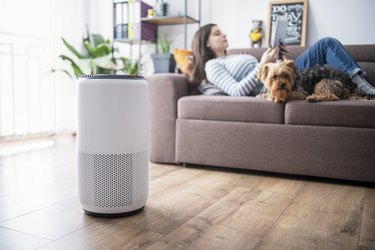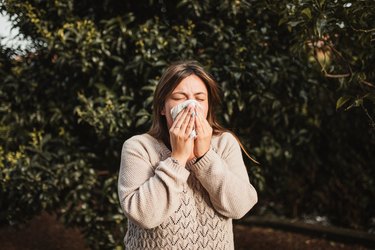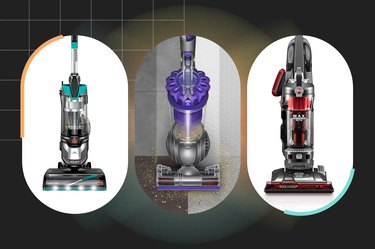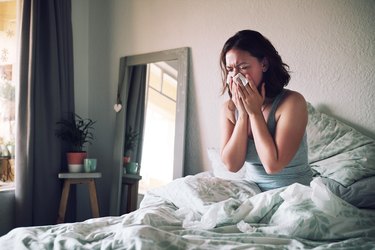
When you have allergies — whether they hit in the spring, summer, fall or year-round — you know how miserable the runny nose, itchy eyes and constant sneezing can make you feel. And guess what: Considering up to 30 percent of people worldwide have seasonal allergies, according to the American College of Allergy, Asthma & Immunology (ACAAI), you know that some allergy doctors get them, too.
That means allergy pros need to use the same medication, prevention and management strategies they talk to patients about all the time. (And yes, sometimes they still sneeze.)
Video of the Day
Video of the Day
Here's how allergists manage their seasonal allergies — and what you can learn from their tips, so you can be more comfortable this year.
1. Wear a Mask When Doing Outside Work
Gardening? Raking or blowing leaves? Mowing your lawn? Whatever you're doing outside, if you're working with plants and grass, pop on a mask.
Warren Filley, MD, emeritus clinical professor of medicine at the University of Oklahoma Health Sciences Center and a fellow of the ACAAI, tells LIVESTRONG.com he prefers the N99 masks from British company Respro, which feature an exhalation valve, allowing you to breathe with ease when working in your yard (or exercising on a high pollen count day).
You don't have to purchase that exact mask, but know that wearing a comfortable-but-tight-fitting mask while doing yard work can make the experience way more pleasant.
The benefit of wearing a mask when outside is that "it prevents you from inhaling the pollen, dirt or allergens that are around," Dr. Filley says. "Once allergies get going, they cycle and become more inflammatory."
Making an effort to limit your exposure while still doing the activities you love (or need to do) plays a large role in allergy management.
Similarly, wear gloves, a hat and protective clothing while doing yard work. "I'm an active gardener. I wear all kinds of protective devices when I go out and do these jobs," Dr. Filley says.
Not only do they help keep pollens off your skin and out of your hair, but they protect you against contact allergens (such as certain plants that can cause skin irritation).
2. Find the Right Medication Regimen
Chris Brooks, MD, allergy and immunology doctor at The Ohio State Wexner Medical Center, lives with grass and dust mite allergies. He relies on over-the-counter medication to help control his symptoms, he tells LIVESTRONG.com. Here's what he does:
- Takes cetirizine (Zyrtec), an oral antihistamine daily
- Uses one spray per day of fluticasone (Flonase) in the morning, a nasal steroid spray that targets sneezing, runny nose, nasal congestion, itchy nose and itchy, watery eyes
- Uses one spray of azelastine (Astepro), an antihistamine nasal spray, in the evening. "I can feel an immediate relief of my symptoms when I use this," Dr. Brooks says. The good news about azelastine is that it just recently became accessible over-the-counter within the last two years, so it may be one tool newly available to you. (Steroid nasal sprays like Flonase work differently in the body than antihistamine sprays like Astepro, so using a combination may help you find more complete relief than using just one or the other.)
His medication regimen is one that he's found works for him, but your needs may be different, depending on your symptoms and individual reactions to each medication. Plus, there are a variety of brand-name and generic allergy medicines to choose from.
One thing to consider, says Dr. Filley, is that brand-name and generic medications may work differently for some people. When you're on the hunt for the medications that will work best for you, he recommends buying the smallest amount of a brand-name medication and trying it. If it works well for you, buy the generic version next and see how it compares. (Generics are generally less expensive than brand names.)
And keep in mind that your response to a particular medication may change or wane over time. If you notice a medication you're taking isn't working as well as it used to, try switching to a different one, or even alternating meds every few months.
"I have my favorite medication, but that doesn't mean it's the right choice for someone else," Dr. Filley says.
If you need help identifying the right regimen for you, talk to your primary care physician or a board-certified allergist.
Tip
Keep side effects in mind when using allergy medications. Astepro, for example, can cause heavy nosebleeds in some people, according to the Mayo Clinic, along with burning or discomfort inside the nose, ear congestion, sore throat and headache. Talk to your doctor or pharmacist about how to manage these and other side effects that may crop up.
3. Have a Nighttime Allergy Routine
Before you go to bed, make sure the pollen and allergens from the day are washed away. Here's what Dr. Brooks does:
- Shower at night. Morning bathers might want to consider flipping their schedule around. "Taking a shower at night helps rinse off pollens or other allergens before sleep," Dr. Brooks says.
- Rinse with nasal saline. You can use a sinus rinse, like NeilMed's Sinus Rinse ($8.99, Amazon) or Neti Pot ($14.67, Amazon), or a nasal saline spray. Choose the product you find the easiest and most pleasant to use. Dr. Brooks likes a spray mist because he says he finds it more convenient.
- Use a nasal antihistamine spray: Wait five minutes after the nasal saline, then follow up with a nasal antihistamine spray such as Astepro ($37.94, Amazon).
4. Run a HEPA Air Purifier
When Clifford Bassett, MD, founder and medical director of Allergy and Asthma Care of New York and medical spokesperson for the Asthma and Allergy Foundation of America (AAFA), was in college, he visited the ER three times during spring break for wheezing. Turns out, he was sleeping near a litter box and was allergic to cat hair, which triggered his asthma.
When patients come in with a dog or cat hair allergy, he recommends investing in a good HEPA air purifier. "I have found that my patients have significant improvement and control of pet allergic symptoms with one," he says.
HEPA air filters reduce and remove allergens in the air. You can find options certified "asthma and allergy friendly" on the AAFA's website. A few to consider:
5. Start Medications Early
The longer you wait to treat the runny, stuffy nose and itchy eyes, the worse these symptoms get as the season progresses.
"One of my best tips is to be proactive by starting pre-seasonal treatment one to two weeks before the onset of pollen season in your area," Dr. Bassett says.
The start of allergy season differs by area and can start well before you'd expect. For instance, spring allergies can begin in February in some parts of the U.S., according to the ACAAI.
With an early start, you'll breathe easier all season.
- American Academy of Allergy, Asthma & Immunology. “Allergy Statistics.”
- National Library of Medicine: “Flucticasone Nasal Spray.”
- U.S. Food & Drug Administration: “FDA Approves a Nasal Antihistamine for Nonprescription Use.”
- American Academy of Allergy, Asthma & Immunology: “Seasonal Allergies.”
- Mayo Clinic: "Azelastine"
Was this article helpful?
150 Characters Max
0/150
Thank you for sharing!
Thank you for your feedback!
Is this an emergency? If you are experiencing serious medical symptoms, please see the National Library of Medicine’s list of signs you need emergency medical attention or call 911.


